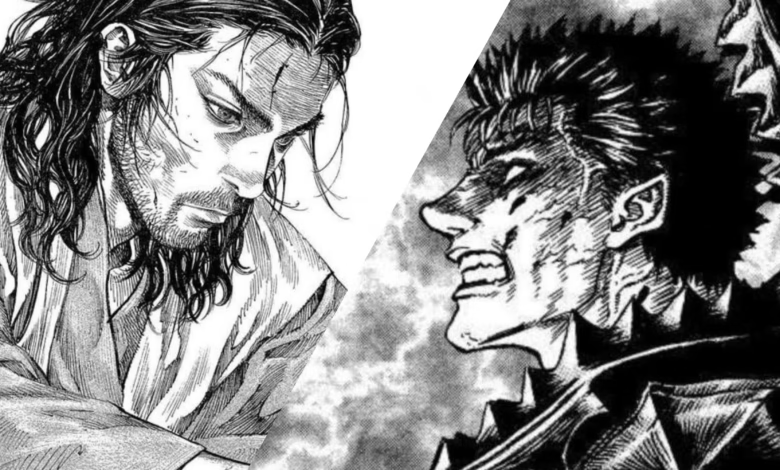Vagabond Manga Review: Why This Series is a Must-Read for Manga Fans

Vagabond, a manga series created by Takehiko Inoue, is a masterpiece that has captivated the hearts of readers around the world. It is based on Eiji Yoshikawa’s historical novel Musashi, and it has since evolved into a powerful narrative that blends action, philosophy, and stunning artistry. With its deep exploration of the samurai code, the internal struggles of its protagonist, and its breathtaking visuals, Vagabond stands as one of the most influential and celebrated mangas in the genre. In this article, we will delve deep into the story, characters, artistic style, themes, and cultural impact of Vagabond, explaining why it remains a revered work in the world of manga.
1. The Story Behind Vagabond Manga
Origin and Inspiration
The origins of Vagabond lie in Eiji Yoshikawa’s novel Musashi, which is based on the true story of Miyamoto Musashi, one of Japan’s most famous samurais. While the novel was published in 1935, Inoue’s manga adaptation, which began serialization in 1998, took the story to new heights, combining historical elements with his own unique artistic vision. Inoue’s deep understanding of the samurai ethos and his creative approach to storytelling resulted in a series that redefined the samurai genre in manga.
Inoue, who had already made a name for himself with his previous work Slam Dunk, approached Vagabond with a more mature and reflective tone. His adaptation of Musashi focuses not just on the physical battles but also on the psychological and philosophical journey of the main character. The manga’s ability to blend the historical aspects of Musashi’s life with Inoue’s own interpretation of the story makes it a profound experience for readers, offering them more than just action-packed sequences.
Plot Summary
At its core, Vagabond follows the journey of Miyamoto Musashi, a young, rebellious swordsman who embarks on a path of self-discovery after a violent and traumatic encounter. The manga traces Musashi’s transformation from a ruthless, bloodthirsty warrior to a figure of wisdom and inner peace. His encounters with other legendary figures, such as Sasaki Kojiro, are key to his development, both as a warrior and as a person seeking meaning beyond the sword.
Musashi’s quest is not just for mastery over the art of sword fighting but also for understanding his own place in the world. The plot is layered with themes of isolation, honor, morality, and the nature of true strength. As he confronts adversaries both external and internal, Musashi learns that the greatest battle is often within oneself. His journey is both a physical and philosophical one, filled with moments of deep reflection and self-exploration.
Historical Context
The historical backdrop of Vagabond is rich with details of feudal Japan, where honor, duty, and violence were deeply ingrained in the culture. Inoue’s meticulous research into this period allows him to create a world that feels authentic while still weaving in fictional elements to enhance the drama. The samurai code of bushido, with its emphasis on loyalty, discipline, and honor, plays a pivotal role in the story, influencing Musashi’s decisions and the conflicts he faces.
Vagabond’s portrayal of feudal Japan provides a window into a tumultuous time in history, but it also invites readers to reflect on universal themes that transcend time and place. This historical and philosophical depth is what sets Vagabond apart from other samurai stories, making it more than just an action-packed series.
2. Character Development in Vagabond Manga
Miyamoto Musashi
Musashi is not merely the protagonist of Vagabond; he is a complex character whose evolution forms the heart of the series. Initially, Musashi is portrayed as a wild, untamed swordsman driven by a desire for vengeance and fame. He is far from the serene and wise figure that the world would come to know. His brutal nature and thirst for strength are palpable in the early chapters, making him seem like an unstoppable force of destruction.
However, as the story progresses, Musashi begins to question the purpose of his violence. His encounters with various characters, each with their own philosophies and reasons for living, challenge his worldview. One of the most significant relationships is with Sasaki Kojiro, a fellow swordsman who embodies a different kind of strength—calm, controlled, and focused on artistry rather than brute force. This rivalry pushes Musashi to refine not just his swordsmanship but his understanding of life itself.
Throughout the manga, Musashi’s internal conflict is portrayed with depth and sensitivity. His transition from a warrior driven by external motives to one who seeks peace and enlightenment is a poignant journey that resonates with readers. The character of Musashi in Vagabond is not just about physical battles; it is about the battle within oneself.
Supporting Characters
While Musashi’s journey is central to the story, Vagabond features a rich cast of supporting characters who influence his path in profound ways. Characters like Otsu, who embodies the theme of love and devotion, and Sasaki Kojiro, who serves as Musashi’s foil, are integral to Musashi’s development. These characters are not merely sidekicks or plot devices but fully realized individuals with their own motivations, struggles, and growth arcs.
Otsu, for example, represents a connection to the emotional and human side of Musashi, contrasting with his more solitary, warrior-like existence. She challenges him to reconsider his views on love, duty, and personal connections. Similarly, Kojiro’s calm demeanor and mastery of swordsmanship provide Musashi with the perfect counterpoint to his own chaotic nature, pushing him to refine his skills and thoughts.
The supporting cast of Vagabond helps to broaden the themes of the manga, showcasing the complexity of human relationships, honor, and the diverse paths people take toward understanding themselves and their place in the world.
Antagonists and Rivalries
Musashi’s adversaries, especially Sasaki Kojiro, are not simply obstacles to be overcome in battle; they serve as philosophical challenges. The rivalry between Musashi and Kojiro is one of the most compelling aspects of Vagabond, as it represents two very different approaches to life and combat. Where Musashi is wild and unpredictable, Kojiro is calm, composed, and driven by a deep sense of artistry in his swordsmanship.
These rivalries are not just physical contests but intellectual and spiritual challenges that force both characters to confront their inner selves. Musashi’s battles, both with others and within himself, provide the manga with its emotional depth, making each confrontation more than just a fight to the death—it becomes a battle for the soul.
3. Artistic Excellence: The Visual Mastery of Vagabond
Takehiko Inoue’s Art Style
Inoue’s art in Vagabond is a testament to his skill as a storyteller and artist. The manga is known for its breathtaking attention to detail, from the finely drawn characters to the intricately designed battle scenes. The artwork is not just a visual accompaniment to the story; it plays a vital role in conveying the emotions, themes, and intensity of the narrative.
Inoue’s use of line work and shading creates a stark contrast between moments of action and introspection, allowing readers to feel the weight of each scene. His action sequences are fluid and dynamic, capturing the motion and power of each sword fight, while quieter, reflective moments are rendered with a delicate and subdued beauty that underscores the emotional depth of the characters.
Use of Realism and Symbolism
What makes Inoue’s art even more remarkable is how he blends realism with symbolism. The physical battles in Vagabond are often depicted with gritty realism, showcasing the brutal nature of combat. Yet, at the same time, Inoue uses symbolism to represent the psychological and emotional battles that Musashi faces. The careful use of negative space, facial expressions, and symbolic imagery creates a rich, layered experience for the reader, where every panel feels meaningful.
The art in Vagabond enhances the story in a way that words alone could not. It gives the narrative a visual depth that invites readers to explore not just the events of the story but the underlying emotions and philosophical questions that arise throughout Musashi’s journey.
4. Themes and Philosophies in Vagabond Manga
The Quest for Self-Realization
One of the central themes in Vagabond is the quest for self-realization. Musashi’s journey is not only about becoming a better swordsman but about understanding the deeper meaning of life. This search for truth and purpose drives the story forward, as Musashi grapples with questions about his existence and the nature of strength.
His experiences with various characters, each embodying different aspects of philosophy, force him to confront his own beliefs and assumptions. Musashi’s evolution from a warrior motivated by pride and vengeance to a figure seeking inner peace and wisdom is the emotional core of the manga. His journey reflects the universal human experience of self-discovery and the struggle to find meaning in a chaotic world.
Violence, Honor, and Morality
Vagabond explores the complex relationship between violence and honor. The samurai code of bushido is a central element in the manga, and Musashi’s adherence to this code is often tested as he faces the brutal realities of warfare. The manga examines whether honor can justify violence and what it truly means to live a life of integrity.
Through Musashi’s inner conflict, Vagabond asks difficult questions about morality and the consequences of one’s actions. The manga does not offer simple answers, instead leaving readers to reflect on the nature of honor, duty, and the meaning of true strength.
5. The Cultural Impact of Vagabond Manga
Influence on Samurai Stories and Manga
Vagabond has had a profound influence on the samurai genre, not just within manga but also in popular culture at large. Inoue’s unique approach to blending historical fiction with deep philosophical inquiry has inspired a new generation of manga artists and writers to take a more introspective and nuanced approach to storytelling. Vagabond has elevated the samurai genre, showing that it is not merely about sword fights but about the internal struggles that shape a person’s life.
The series has garnered a global following, and its impact can be seen in many modern manga that explore similar themes of self-discovery, morality, and personal growth. Its success has helped to bring historical manga to a wider audience, proving that stories of the past can resonate with readers in the present.
Critical Acclaim and Awards
Vagabond has received numerous awards and accolades, cementing its place as one of the greatest manga series ever created. It has been praised not only for its artistic brilliance but also for its thought-provoking narrative and emotional depth. Its critical success is a testament to Inoue’s skill as a storyteller and his ability to connect with readers on a deeply personal level.
Conclusion: A Timeless Masterpiece
Vagabond is more than just a manga; it is a profound exploration of the human condition through the lens of samurai culture. With its unforgettable characters, philosophical depth, and stunning artwork, it continues to be a landmark work in the world of manga. Through Musashi’s journey, readers are reminded that the greatest battles are not those fought with swords but those fought within the soul. Vagabond’s legacy as one of the most influential mangas ever created remains undiminished, and it will continue to inspire and captivate readers for generations to come.

